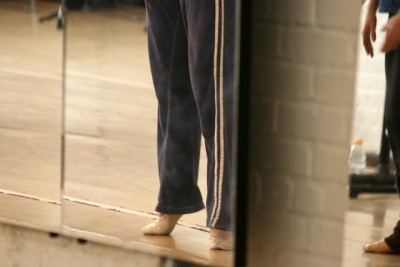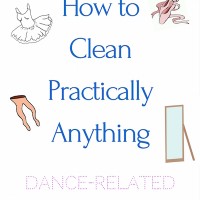
“How do I clean my ____?”
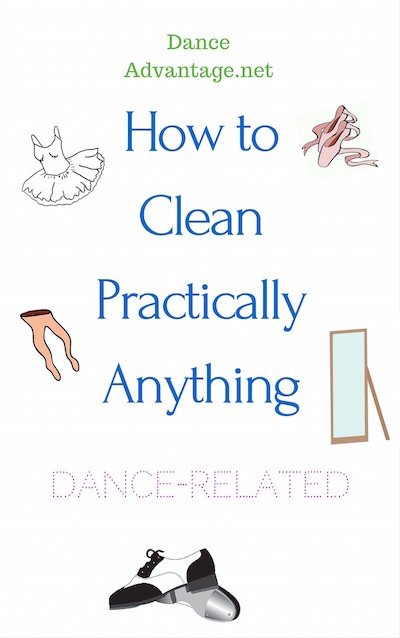 It’s no secret that dance isn’t always glamorous but your dance stuff doesn’t need to be the dead giveaway. Because dance gear doesn’t always come with instructions for proper care, we’ve gathered tips and advice on cleaning practically everything dance-related. Now you can leave the “Dirty Dancing” to Patrick and Jennifer with these tips for making shoes, dancewear, costumes, floors, and more look good as new.
It’s no secret that dance isn’t always glamorous but your dance stuff doesn’t need to be the dead giveaway. Because dance gear doesn’t always come with instructions for proper care, we’ve gathered tips and advice on cleaning practically everything dance-related. Now you can leave the “Dirty Dancing” to Patrick and Jennifer with these tips for making shoes, dancewear, costumes, floors, and more look good as new.
Cleaning Dance Shoes
We’ve already covered basic dance shoe care, including storage and repair but if your shoes could use some sprucing up, here are some detailed cleaning tips:
Leather Ballet Slippers
Leather ballet slippers can easily be spot cleaned. Sometimes just a soft, damp cloth will do.
For a deeper cleaning, use a mild detergent or dish soap. There are two ways to do this: 1) rub a drop of detergent onto the soiled shoe and then wipe it clean with a soft, dry cloth or toothbrush or 2) add a few drops of detergent into a cup of water and mix until sudsy, then apply to shoe with a soft cloth.
Leather cleaner can also be used but be sure to apply a conditioner to keep the leather supple. Other commonly-used methods include using melamine foam (more popularly known as a Mr. Clean eraser), or Windex (sprayed onto a paper towel or cloth, not directly on the shoes) to clean your leather slippers.
Leather ballet slippers should NOT be cleaned in the washing machine. If your shoes are beyond spot cleaning, you can hand-wash them with a bit of mild detergent. It’s a good idea to wear the slippers while damp to allow them to mold to your foot.
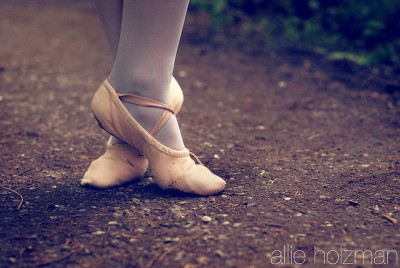
“ballet shoes” by Allie Holzman is licensed CC BY-ND 2.0
Keep in mind that water can make leather brittle so any method involving water should be used as little as possible clean your ballet slippers.
Canvas Ballet Slippers
Canvas ballet slippers can be cleaned in the washing machine. It’s best to wash them as you might other delicates: put them in a small lingerie bag and wash on cold, delicate cycle with a mild detergent. Don’t use fabric softener or bleach products.
DO NOT tumble your canvas ballet shoes in the dryer. Reshape them and lay them out on a towel to dry.
Washing canvas ballet slippers with this method may remove most dirt and grime but does not always restore the lovely pink or blush color of your shoes. For performance, many dancers dab either a matching foundation makeup or calamine lotion (which has a pink color) onto canvas slippers with a soft cloth, makeup sponge, or cotton ball to make them look like new on stage.
Pointe Shoes
What do the Wicked Witch of the West and pointe shoes have in common? Both can be destroyed by water. What a world, indeed!
Because of this fact and the generally short lifespan of a pointe shoe, most dancers just conceal dirty spots with foundation or calamine lotion before a performance. Students who do not go through shoes as quickly, may prefer to keep their pointe shoes clean and shiny by using pointe shoe covers during class.
All cleaning methods will dull the shine of pointe shoes but it that’s not a concern, there are a couple of ways to clean the satin. You may use dish detergent mixed into a small amount of water to spot clean a pointe shoe. Just be very careful not to saturate the shoe or you will risk breaking down the glue needed to help support the foot en pointe.
Another recommended cleaner is baking soda. Mix it with a bit of water until it forms a thick paste. Apply a small amount of the paste to spots and stains with a soft cloth or toothbrush and gently rub into the fabric with a circular motion. Allow the paste to dry overnight and wipe away the now chalky paste with a warm, damp (not wet) towel or washcloth – use a clean part of the towel for each spot to get all the chalky substance off the shoe. This will fade if not remove any marks on the pointe shoe but it will also dull the shine.
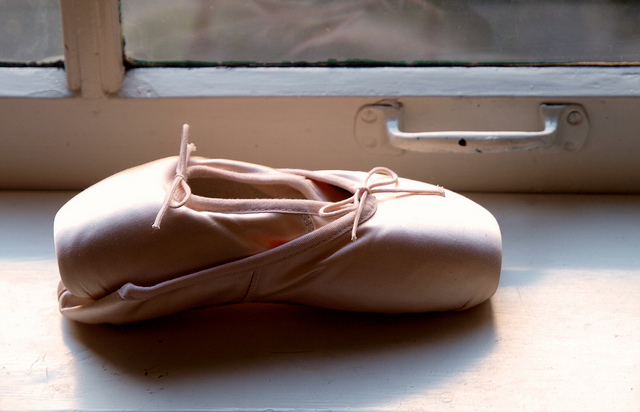
“new pair of pointes” by mararie is licensed CC BY-SA 2.0
Tap/Jazz Shoe Scuff Marks
Surface grime and unsightly scuff marks can sometimes be removed from leather tap or jazz shoes by using baby wipes but most people swear by melamine foam for getting rid of marks from tap shoes and jazz shoes of any color. For stubborn scuffs, some apply pure acetone (nail polish remover) with a soft cloth, cotton ball, or Q-tip. Be sure not to rub too hard when using these methods as it’s possible to rub color from the shoe.
After cleaning the scuff, restore the shoe’s shine with a bit of petroleum jelly (Vaseline) or a matching shoe polish.
As with leather ballet slippers, matching foundation can be applied to tan leather tap or jazz shoes to temporarily improve their look for performance.
Because cleaning jazz shoes in the washing machine isn’t an option, shoes can get pretty stinky over time. You can find some odor-eliminating options at getsmellout.com (Remember, use the sprays recommended via the link only on the inside of the shoe. Also, leaving shoes in the sun to dry can damage the color – try using a blow dryer on cool to dry instead.)
Cleaning Dancewear
Yes, almost all dancewear for class like leotards and tights can be thrown in the wash. These items will last much longer if they are washed in cold water and a mild detergent without bleach (don’t use fabric softener) on the hand-wash or delicate cycle. Putting them in a lingerie bag provides further protection from snags and from getting stretched out of shape.
I know for time’s sake, some dancers tumble dry their leotards on low heat. If you want your dancewear to last, though, it is best to lay it out to dry because heat gradually ruins the elasticity of stretch fabrics.
Greying Tights
If you or your kids have been dancing for a while, you know how quickly pink tights start to look grungy and grey, especially around the heels and toes. According to one blogging dance mom, the absolute best way to wash dirty tights is with a bar of Dove soap. Scrub the soap directly into the stains – really lather them up. Then, rinse them thoroughly with cool water and hang to dry. Apparently, this method is no match even for red lipstick!
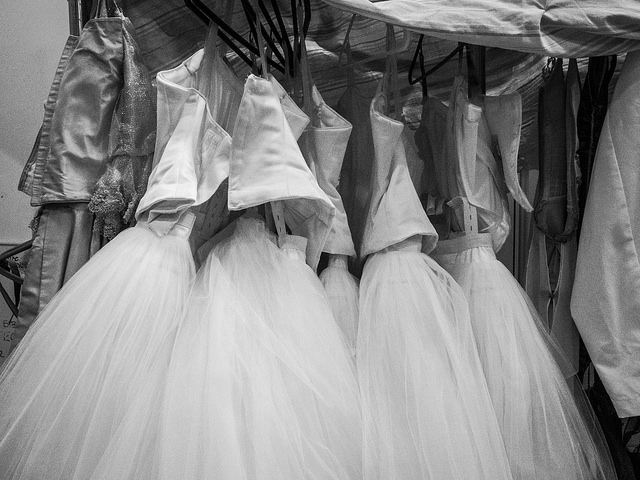
Cleaning Costumes
Costumes made from durable fabrics like cotton/polyester blends, polyester, nylon, etc. can usually withstand machine washing and low-heat tumble drying unless they are trimmed or embellished with sequins or stones. If they are, handwash them.
Handwash anything made from delicate fabrics like lycra, spandex, tulle, cotton, linen, or knits. Hang-dry delicates or lay them flat if they contain stretch fabrics. Make any need repairs to costumes prior to washing them so there is no further damage.
Use a reputable dry cleaner for anything made of fabrics like wool, leather, chiffon, velvet, rayon, or satin. Keep in mind, however, it’s not recommended that you dry-clean costumes with stone or sequins embellishments. In fact, it’s best to spot-clean whenever you can as fabrics are damaged over time by harsh dry-cleaning chemicals.
Some costumes with heavy embroidery should never be washed. Dancers should wear leotards, tights, or other undergarments if possible to reduce the amount of perspiration on the fabric. You can eliminate odor with sprays (make sure you test them on an inconspicuous spot first). The wardrobe departments of many dance companies will hand wash only the panty area of a ballet bodice and use fabric-refresher sprays on the armpits or anywhere the bodice touches the dancer’s skin. A 50/50 dilution of alcohol and water can kill bacteria and odor without damaging the garment.
Wrinkles aren’t really part of cleaning but they do come as a result of it sometimes. To iron wrinkled costumes, turn them inside out and use a cool setting with a towel between the iron and fabric. Steam anything that is too delicate for ironing like tutus. Many dancers rely on hot shower steam to get the wrinkles from their costumes.
Leave the “Dirty Dancing” to Patrick and Jennifer with these tips for cleaning your dance gear.
Click To Tweet
Cleaning Marley Floors
Poly-vinyl-chloride (PVC), or marley flooring is often used in dance studios and for performance. Typically manufacturers supply very detailed instruction on the proper care and maintenance of these floors. If you want the floor to last, follow their instructions! The main points to remember for cleanliness and your dancers’ safety are as follows:
- Keep street shoes off the dance floor — they bring in abrasive dirt and grime. Better still, have dancers wait to put on their shoes until they are in the studio to avoid bringing in debris from the lobby, dressing rooms, etc.
- Dry mop or sweep the floor daily using a clean mop/broom. (Do not use anything that is oil-treated.)
- Do not use household cleaners and avoid cleaners with acetone, alcohol, ammonia, or bleach.
- Use a neutral pH cleaner only and, for very dirty floors, a degreaser.
- Humidity makes the floor slippery. If this is a problem, use a dehumidifier overnight.
- Deep clean your floor bi-monthly or quarterly (depending on your studio traffic). A commercial wet-vac or automatic scrubber is often recommended.
Scuff Marks
There are different kinds of scuff marks – rubber, metal, leather – when soles begin to disintegrate, they leave behind residue on your dance floor. Even dye from a shoe can leave a mark on your marley floor that is tough to get rid of. The key to successfully removing all scuffs is to get to these marks as fast as possible. Therefore, your best defense may be a routine daily cleaning schedule so that problems are spotted right away.
There are products sold by dance floor manufacturers specifically for removing scuff marks from vinyl. Yes, they are expensive but keep some on hand for times when stubborn scuffs don’t come up with regular cleaning.
If tap dancers use your floor, have artificial chamois cloths handy to use on your dry mop (or swiffer). Lower-quality, aluminum compound taps break down and the shards stick to your floor. The artificial chamois will help to clear this residue. A wet/dry shop vac may also be used.
Cleaning Mirrors
Glassless Mirrors
Many studios now use glassless mirrors because they are shatterfproof. To clean glassless mirror, first remove dust and debris from the surface of the mirror with dry compressed air. Finger marks or splashes can be wiped gently with window cleaner and a soft, non‐abrasive cloth (100% cotton or micro-fiber will do). Do not use paper towels and do not scrub the mirror surface in a circular motion.
Glass Mirrors
It’s no longer true that newspaper is the best way to clean glass mirrors because the inks used on newspaper have changed over the years. So what is the best method?
- First, use rubbing alcohol on a cotton pad to spot-clean any sticky spots on the mirror like hairspray, or whatever was on your preschool students’ fingers before they came to class.
- Next, mist vinegar and water or your favorite glass cleaner onto the surface of the mirror.
- Then, use a folded flat weave microfiber cloth to wipe the mirror in a zig-zag pattern (sweep from left, down a little, go back from right, repeat) so that you don’t miss any of the mirror’s surface.
- Use a dry part of the cloth and repeat this process on each section or panel of the mirror.
Mixed Materials
What about things made of a variety of materials? We recently received an email about how to clean spilled milkshake from a dance sneaker for example!
Our best advice for this kind of dance gear, whether you wear it, carry it, or stuff it in your dance bag, is to research the list of materials of which product is made. Online stores or the manufacturer’s website will often give a basic list in the description if you look carefully. In the case of the milkshake debacle, the sneaker was made of mesh, leather, and other materials, each of which needs to be cleaned in a slightly different way. Just throwing them in the wash and hoping for the best is a great way of ruining an expensive pair of shoes. In cases like this, Google may definitely be your friend.
How about cleaning dances? ![😉]()
Ha ha! We thought about adding that to this already long post but it really deserves its own feature.
As for the cleaning tips and advice we have included, we’ve done our best to compile information from experience and trusted sources but, as always, the information offered is for educational purposes only. This includes anything readers place in the comment section. We can’t be held responsible for any outcome of what you, the reader, decide to do with the information presented here.
